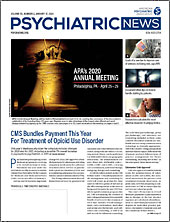Approximately 2.2 million children in the United States either had opioid use disorder (OUD) or had a parent who had OUD in 2017, according to a report released by the United Hospital Fund and Boston Consulting Group (see
chart). The analysis revealed a wide variation among states in the number of children affected by the opioid crisis. West Virginia had the highest rate, with 54 out of every 1,000 children affected, and California had the lowest rate, with 20 out of every 1,000 affected. Of the children affected nationwide, more than 900,000 were aged 5 years or younger, and nearly 1.6 million were younger than 12 years.
The report’s authors predict that if current trends continue, the number of children affected by opioid use and misuse will rise to an estimated 4.3 million by 2030. Furthermore, the cumulative lifetime cost will reach $400 billion in additional spending on health care, special education, child welfare, and criminal justice. In a more pessimistic scenario, the number of children affected by the opioid crisis could rise to 5.3 million. Even in an optimistic scenario, the number of children affected would rise to 3.4 million.
“Growing up in a household with substance use exposure is an adverse childhood experience (ACE) and can make children vulnerable to additional ACEs, such as abuse and neglect, loss or separation from a parent, or exposure to violence. The presence of such potentially traumatic experiences can be especially harmful to young children, as it can interfere with brain development,” the authors wrote. “Recent research, however, teaches us that these ACEs can be prevented or their impact reduced, if these children and their families receive appropriate support.”
To that end, the report includes the following 10 strategies that can help children affected by opioids:
•
Reduce stigma and misunderstanding of opioid use and treatment.
•
Coordinate the response across health care, law enforcement, child welfare agencies, and schools.
•
Create protocols for emergency responders to connect children to recovery services.
•
Provide caregivers and foster parents with tools for responding to trauma in children.
•
Encourage schools to practice trauma-informed care.
•
Research the needs of youth caregivers and develop programs to support them.
•
Increase the availability of family-based mental health services.
•
Invest in evidence-based programs for youth development.
•
Encourage integrated health and social services that simultaneously meet the needs of parents and children.
•
Reduce geographic and racial/ethnic disparities in access to services.
Psychiatrists can deliver much-needed care and treatment, said Anish Ranjan Dube, M.D., M.P.H., a child and adolescent psychiatrist in Orange, Calif., and a member of APA’s Council on Children, Adolescents, and Their Families. Dube stressed the importance of family-based interventions and a family-based approach to care, whether treating adults with an OUD or their children.
“As child and adolescent psychiatrists, we are optimally trained and well situated to advocate for our patients and to help implement interventions across health care, law enforcement, child welfare agencies, and schools,” said Dube, who was not involved in researching or writing the analysis.
The report was produced through a pro-bono engagement between the United Hospital Fund and Boston Consulting Group. ■
“The Ripple Effect: National and State Estimates of the U.S. Opioid Epidemic’s Impact on Children” is posted
here.

